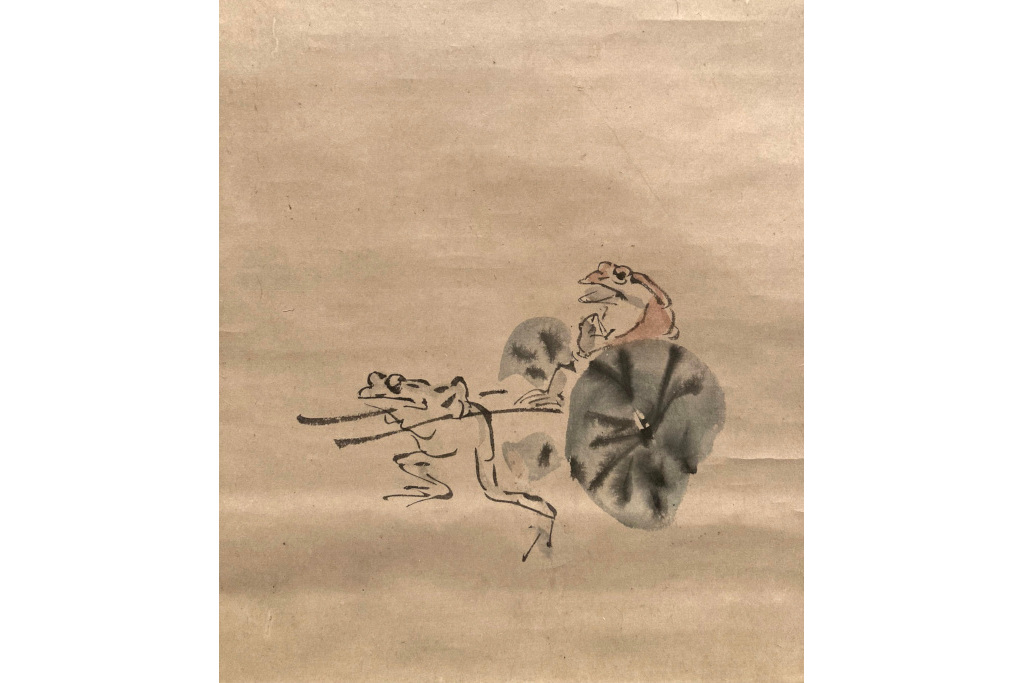5 Reasons to Visit ‘Kyōsai: The Israel Goldman Collection’ at the Royal Academy
By
3 years ago
Expect laughs, social commentary and a lot of frogs

Did you know Japan only opened its doors to the Western world in 1854? For how much we love the country now for its leaps in technology, innovative storytelling and culinary treats, we still have much to learn when it comes to its continually shifting artistic landscape. In its latest exhibition, Kyōsai: The Israel Goldman Collection, the Royal Academy allows visitors to see the Land of the Rising Sun through one of its most famed painters: Kawanabe Kyōsai.
5 Reasons to Visit Kyōsai: The Israel Goldman Collection at the Royal Academy
1. You can get to know one of Japan’s most famous painters
This is Kawanabe Kyōsai’s first monographic exhibition in the UK since 1993. A lot has changed in just under 30 years, let alone the 133 since the Japanese artist’s death. Kyōsai was considered one of the most exciting painters of his time, starting out as a child prodigy and later becoming one of the first political caricaturists of Japan. Kyōsai: The Israel Goldman Collection showcases around 80 of his artworks – many of which have never been exhibited or published before – and the curatorial team at the Royal Academy have delved deep into the historical context of each artwork to centre the exhibition on three themes: ‘From Tradition to Innovation’, ‘Laughing at Modernity’ and ‘The Artist meets his Public’.
2. Kyōsai was known for his explosive humour
Comedy intertwines with social commentary in many of Kyōsai’s artworks. The artist originally studied under ukiyo-e artist Utagawa Kuniyoshi, before receiving academic training from the Kanō school of painting. But despite his traditional background, Kyōsai was curious about the world around him and endeavoured to create art that bridged the space between art and popular culture. The result? Often hilarious renderings of Buddhist mythology, Japanese social circles and Western fashions. The exhibition focuses largely on the art of ‘spontaneous paintings’ (sekiga) produced at calligraphy and painting parties (shogakai), which were often fuelled by prodigious amounts of saké – which should help set the scene for the kinds of subjects Kyōsai depicted.

Kawanabe Kyōsai, A Beauty in Front of King Enma’s Mirror, 1871–89 (1887?). Hanging scroll: ink, colour and gold on silk, 35.3 × 52 cm. Israel Goldman Collection, London. Photo: Ken Adlard
3. The frogs
Kyōsai often depicted people as ‘humanised’ animals – often to avoid political censorship when depicting the likes of war and social upheaval, but also as a means of inflicting his subjects with funny characteristics. Many of the paintings and drawings on show therefore depict animals mimicking the lives of humans in one way or another. But none feature quite so prominently as frogs. As you make your through the gallery, expect to find them somersaulting as acrobats, carting each other around in rickshaws, fighting wars in armour and teaching in outdoor classrooms. These charming characters take over all three rooms of the exhibition, and will more than likely be the cause for a smile or two.

Detail of a Kyōsai painting
4. East meet West like never before
Kyōsai lived during a time when Japan had only recently opened its borders to the rest of the world, letting in an influx of foreign influences from the West. Kyōsai himself was noted for interacting with the first generation of Western artists, writers and diplomats to visit Japan, such as British architect, Josiah Conder, and the founder of the musée Guimet, French industrialist Émile Guimet. In the ‘Laughing at Modernity’ section of the exhibition, visitors can see how the artist interpreted this change in the cultural landscape through the lens of humour – depicting encounters with Europeans and Americans, the adoption of Western fashions and customs and even political events and civil wars.

Kawanabe Kyōsai, Skeleton Shamisen Player in Top Hat with Dancing Monster, 1871–8. Unmounted painting: ink and light colour on paper, 29.7 × 39.1 cm. Israel Goldman Collection, London. Photo: Art Research Center, Ritsumeikan University
5. Kyōsai highlights Japan’s community of artists and art-lovers
The exhibition ends on a high with its final section, ‘The Artist meets his Public’, bringing visitors back to the artist’s many sekiga creations. Painted as part of a public performance either at gatherings or on the streets on Japan, Kyōsai’s spontaneous paintings highlight the social function of art-making – as well as the collaborative opportunities it presented. Summarising the section in all its detail is Calligraphy and Painting Party (Shogakai) (c. May 1876 – spring 1878), created in the style of ‘a painting within a painting’. Here, Kyōsai sets the scene of the party, but her leaves the many hanging canvases and papers blank for his fellow artists, calligraphers and poets to fill with their own work. This is a larger-than-life artwork you’ll need to see in person to dissect fully.

Kawanabe Kyōsai and 54 others, Calligraphy and Painting Party (Shogakai), c. May 1876 – spring 1878. Hanging scroll: ink and light colour on paper, 131.5 × 65.5 cm. Israel Goldman Collection, London. Photo: Ken Adlard
Final Word
Full of light-hearted wit, quirky characters and intriguing insight into the artistic world of nineteenth century Japan, Kyōsai: The Israel Goldman Collection offers up an artist who was also a man of the moment – one who drew endless excitement from social change while never losing his sense of humour. This is an exhibition for Japanophiles, art historians and cynics alike.
VISIT
Kyōsai: The Israel Goldman Collection will be showing at the Courtauld Gallery between 19 March and 19 June 2022, with tickets priced at £17 for adults. For more information, please visit royalacademy.org.uk
Featured image: Kawanabe Kyōsai, Frog School, early 1870s. Album leaf: ink and light colour on paper, 19.4 × 29.8 cm. Israel Goldman Collection, London. Photo: Ken Adlard
DISCOVER MORE
The Biggest Exhibitions of 2022 / The Best Art Exhibitions in London



